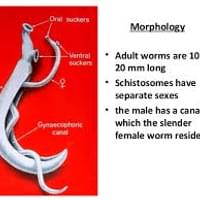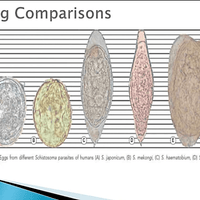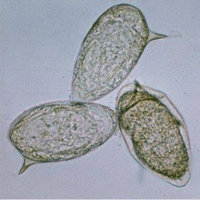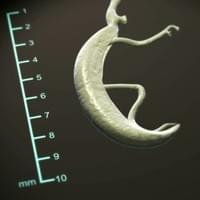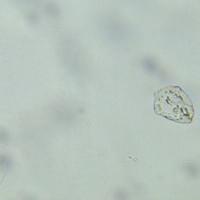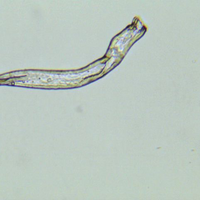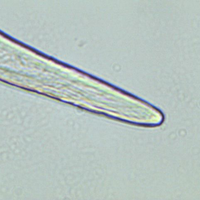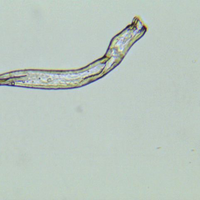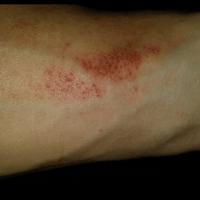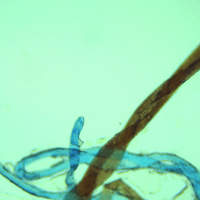

Schistosomiasis.org

Schistosomiasis
Parasite Information
Discovered in 1851 by the German physician Theodor Bilharz
What is Schistosomiasis?
Also known as Snail Fever and Bilharzia this is a disease caused by parasitic flatworms
called schistosomes. The urinary tract or the intestines may be infected.Those who have been infected for a long time may experience liver damage, kidney failure, infertility, or bladder cancer. In children, it may cause poor growth and
learning difficulty. https://en.wikipedia.org/wiki/Schistosomiasis
Where is Schistosomiasis found?
Schistosomiasis is found all over the world usually in developing countries from the Tropics. Thinking of it as a disease of Africa is not correct though; as the world has gotten smaller due to intercontinental flights and migrations. Many years ago we saw it spread following the trade routes of the 1800's today its only as far as your next airplane ticket or local waterway. There are reports of it showing up in fresh waterways in southern France and even the Caribbean islands, think about that the next time you book a holiday. The highest levels of schistosome transmission are in communities living near freshwater lakes and rivers.
Around 240 million people worldwide have it and more than 200,000 deaths per year are a result of schistosomiasis.Schistosomiasis is now being found in first world countries such as the US and UK from persons with no travel history to endemic countries.
How is Schistosomiasis transmitted?
Individuals get infected when they come into contact with fresh water contaminated with the schistosome parasite. Fresh water becomes contaminated with the parasite when individuals infected with schistosomiasis urinate or defecate in the water, releasing the parasite’s eggs, which later hatch.The parasite larvae then develop and multiply inside specific types of freshwater snails, before re-entering the water. Then it can survive for up to 48 hours in the water as it swims around looking for a human host to infect.
Recent developments have revealed that Schistosomiasis can be transmitted sexually between partners. Testing is underway and results are coming in of both partners being infected with Schistosomiasis.
How does it affect you?
When the schistosome parasite finds a host in the water, it burrows into your skin where it typically will leave red bumps or a swimmers like rash. After this it makes its way to the capillaries entering into the circulatory system stopping first in the lungs. After that phase the parasite changes into a small worm like parasite and starts to move to your liver. Once in your liver the parasite goes through its final phase and becomes an adult worm where it moves again settling into its residence either the blood vessels located around your bladder (Haematobium)or the blood vessels around your intestines (Mansoni). Once there is when the real damage starts to take place, eggs. Now that the worm is in its adult form it finds a mate and they begin to produce thousands of eggs a day. The eggs migrate through the attaching tissue into either the bladder or intestines to be expelled by the human host and hence perpetuate the cycle all over again. This is where the true damage of the disease takes place as the eggs irritate the linings and cause inflammation. Some of the eggs will be trapped due to your bodies natural defenses and cysts will form that later can develop into cancer. Frequent urination and or frequent deification of loose or floating stool is a strong symptom of schistosomiasis. Why floating? Floating is what the parasites have evolved to do as human host are more likely accessible at the surface of fresh waters.
In STD transmissions the first signs of it show up as an UTI with frequent urination and malaise. If left untreated the more severe and associated schistosomiasis symptoms appear.
If you suffer from IC (Interstitial cystitis) or painful bladder syndrome there is a good chance that it is Schistosomiasis.
Symptoms of Schistosomiasis
- A red rash or bumps on the skin from being exposed to infected water (usually visible in 12 hours after exposure)
- If contracted sexually symptoms show in 24-72 hours after exposure with frequent urination similar to an UTI.
- 2 to10 weeks later the following symptoms can appear
- Chest pain – this is the result of larval parasites moving though the lung tissue and later schistosome eggs becoming trapped in the blood vessels that supply the lungs.
- Dry cough
- Palpitations
- Fatigue
- Poor quality of sleep
- Malaise
- GERD or acid reflux
- Frequent loose or floating stools after eating.
- Diarrhea – schistosome eggs can lodge in the blood vessels of the intestine causing inflammation resulting in bloody diarrhea or diarrhea.
- Constipation
- Joint pain
- Headache
- Neck pain
- Frequent urination of clear urine (every 2 hours)
- Constant urge to urinate even after evacuating bladder
- Pain when urinating – schistosome eggs lodged in the urinary tract cause inflammation and blood in the urine resulting in symptoms similar to urinary tract and bladder infections.
- Blood in urine
- Burning or stinging after urinating
- Urine containing thin black threads
- Dyspareunia (pain during intercourse )
- Vagina pain
- Vaginal discharge (thick white fluid)
- Kidney pain
- Bladder pain
- Low Seminal fluid or semen
- Yellow chunks in sperm
- Hemospermia (blood in sperm)
- Burning after ejaculation
- All symptoms come and go as this is a chronic disease, usually on a 6 week cycle
- Sometimes acute schistosomiasis symptoms can be so mild they go unnoticed
- If left untreated death rate is about 200,000 people per year
- Bladder cancer specifically with Schistosomiasis Haematobium
Treatment
Schistosomiasis haematobium - mansoni- japonica - mekong: Clinically treated with Praziquantel 60mg/kg/dailty orally in 3 divided doses for 1 day.
www.drugs.com/dosage/praziquantel.html
Artemether (6 mg/kg), which is well known for its antimalarial activity, kills schistosomula during the first 21 days in the body.
https://www.karger.com/Article/Pdf/137633
- Female genital schistosomiasis:A pocket atlas for clinical health-care professionals
A Healthcare guide to understanding Female Genital Schistosomiasis.

Avian Schistosomiasis
Trichobilharzia
The bird schistosomes are a group of blood flukes (Platyhelminthes, Digenea). They contain the largest clade of the family Schistosomatidae that includes ten genera: Dendritobilharzia, Gigantobilharzia, Allobilharzia, Austrobilharzia, Anserobilharzia, Trichobilharzia, Bilharziella, Macrobilharzia, Ornithobilharzia and Jilinobilharzia. In the two-host life cycle (fresh water snails as intermediate hosts and aquatic birds as definitive hosts), they develop as adults with in venous and arterial vessels or nasal tissue of their bird host. Bird schistosomes of the genus Trichobilharzia are categorized as nasal and visceral groups depending on their target tissue within the final hosts (Horák et al., 2002; Brant et al., 2006). Cercariae of the bird schistosomes released from intermediate hosts are recognized as the great causative agent of human cercarial dermatitis (HCD) or Swimmer's itch which is considered an emerging disease in various parts of the World (de Gentile et al., 1996). Experiments have demonstrated that avian schistosomes can migrate and partly develop in other bodies of their non-specific mammalian hosts, causing serious health risks. Larvae of different visceral avian schistosome have been detected in the lungs of experimentally infected monkeys and rodents (Horák et al., 2002), and foot paralysis has been seen in mice infected with the neurotropic species Trichobilharzia regenti(Horák et al., 1999; Hrádková and Horák, 1999). Therefore, as a result of these experiments, It is thus considered conceivable that avian schistosomes may be responsible for some nervous or pulmonary symptoms in humans...
https://www.sciencedirect.com/science/article/pii/S2405673120300118
Parasite Blog
12 novembre 2018Read more...We partnered with a I.C. (Interstitial Cystitis) support group in the U.K. and tested them. Most...8 février 2020Read more...During my study of schistosomiasis we were wondering about different body cavities that...13 avril 2019Read more...Every time I have a strenuous workout being it cardio or weights that night and next day I have...Our Schistosomiasis Story
In 2011 I became sick while working overseas in the Middle East with a fever, frequent urination along with kidney and bladder pain plus a long list of other health related problems due to parasites. I returned home gave the disease to my wife and we battled it together. It took me 6 years to finally figure out what was wrong with me as I was diagnosed with Schistosomiasis in 2017. We spent another 2 years trying to figure out how to cure her and remove it from her reproductive tract. I created a new drug to treat (FGS) Female Genital Schistosomiasis.
This has led me to create Schistosomiasis.org Inc. a non-profit organization that is dedicated to the awareness and eradication of Schistosomiasis. Our organization is had at work supporting new drug developments and research for this dreaded disease. Together we can make a difference!
We are helping the world!
Contact Us
schistosomiasis.testkit@
© 2018




